Battleships like "Sevastopol". Success or failure? Part of 3
From the source to the source goes opinion: "Sevastopol differed disgusting seaworthiness and were decidedly unfit to act on the open sea."
On the one hand, arguing purely theoretically, it is difficult to disagree with such a statement. Indeed, the height of the freeboard (according to the project of 6 meters) in the nose did not exceed the 5,4-5,7 meter, and that was not much. In addition, the nasal contours of the hull were too sharp (to obtain a high speed) and did not, in theory, provide good convergence to the wave. And this led to the fact that the first tower was flooded with water.
But what is the matter - the sources write about this more than streamlined. “Even in the conditions of the Gulf of Finland, with little excitement for such large ships, their bow tip dug into the water up to the first tower ...”
So try to guess - "insignificant for such large ships" - how much is this?
It turns out interesting - they talk a lot about low seaworthiness, but there is no specifics about how bad it was. The most important question is: at what point of excitement on the Beaufort scale would the Sevastopol type battleships be able to fight anymore? (Note: Generally speaking, the Beaufort scale regulates not the excitement, but the force of the wind, but we will not go into such jungle, and besides, no matter what, there is a definite relationship between the force of the wind and the excitement in the open sea.)
I could not find the answer to this question. Well, not to take seriously the information that “on a small wave for such a large ship, the optics of its tower spattered”! And that's why.
Firstly, the optics in the tower is an important thing, but in combat the main method of using guns was and remains centralized control of artillery fire, in which the tower optics are secondary. And if the centralized control is broken, and the towers are given the command to fight on their own, then, most likely, the ship itself is hardly capable of delivering a full turn, at which its optics will overwhelm.
Secondly, we take the German battleship Derflinger. In the nose, the height of its freeboard exceeds 7 meters, which is significantly more than that of the Russian battleship, but its feed rose only 4,2 meters above sea level. And then his poop, you say, he's not going astern to go into battle? This is definitely the case. However, I came across data that at the full speed of its feed, inclusive of the barbet of the aft tower, went under water. Hard to believe, right? But in the Muzhenikov book, Germany's Line Cruisers, there is a charming photograph of a battle cruiser at full speed.
At the same time, I have never heard that Derflinger had any problems with the use of tools related to seaworthiness.
Finally, the third. Already after World War I and on the eve of World War II, the British very imprudently demanded that 356-mm guns of the latest King George V type battleships be fired right along the course. Therefore, the nose of the battleship did not receive a forecastle or lift, which adversely affected the ship’s seaworthiness. In the famous battle against the German battleship "Bismarck", the English commanders of the nose tower "Prince of Wells" had to fight while knee-deep in the water - it was overwhelming right through the embrasures of the towers. I fully admit that the optics at the same time was splashing too. But the British fought, and fell, and inflicted damage to the enemy, although the British battleship, which did not complete the full course of combat training in the experience of its crew, was much inferior to the fully trained Bismarck.
As a sample of the useless seaworthiness of our battleships, the unfortunate case is usually brought about when the battleship “Paris Commune” during the transition from the Baltic to the Black Sea landed in the Bay of Biscay in a violent storm that caused the most sensitive damage to our Dreadnought. And some even undertake to assert that there was no storm at all, so, self-indulgence is one, citing the fact that the French maritime meteorological service recorded on the same days a wind of 7-8 points and a wave of the sea 6 points.
I'll start with the storm. It must be said that the Bay of Biscay is generally famous for its unpredictability: it seems that a storm is raging far, far away, on the coast is clear, but in the bay there is a multimeter swell. This is often the case if a storm is coming from the Atlantic to Europe - the coast of France is still quiet, but the Atlantic is seething, preparing to unleash its fury on the coast of Britain, and then it will get to France. So even if the same Brest has no storm, this does not mean that the weather in the Bay of Biscay is excellent.
And during the release of the "Paris Commune" in the Atlantic and off the coast of England, a violent storm raged that destroyed the 35 of various merchant and fishing vessels, and later it reached France.
Our battleship went into the sea on December 7, was forced to return back on December 10. During this time:
- December 7 cargo ship Chieri (Italy) sank in the Bay of Biscay, 80 miles (150 km) from the coast of France (approximately 47 ° XNNXX ° W). Killed 6 from crew member 35. The rest were rescued by the trawler Gascoyne (France);
- cargo ship “Helene” (Denmark) was abandoned by rescuers in the Bay of Biscay after an unsuccessful towing attempt. It was thrown onto the French coast and destroyed by the waves, his entire crew was killed;
- December 8 sailing ship "Notre Dame de Bonne Nouvelle" (France) sank in the Bay of Biscay. His crew was saved.
The only photo of our dreadnought on that trip apparently hints that the excitement was prejudicial.
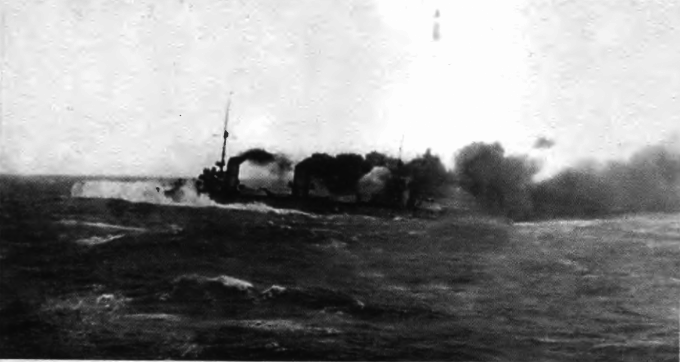
Moreover, the photograph captured the ship clearly not in the midst of the violence of the elements - when a hurricane came along that accompanied the cruiser from which this photo was taken, he himself was damaged, and, obviously, at such a time, he would not have taken a photo shoot from him. And therefore there are no prerequisites to challenge the testimony of Soviet sailors.
But let's move on to the damage of the Russian dreadnought. In fact, it was not his design that was to blame for the damage that a huge ship received, but the technical improvement made to this structure under Soviet rule. In the USSR, the battleship received a nose fix, designed to reduce flooding the bow of the ship. She looked more like a scoop, dressed right on the deck.
In the Baltic, such a construction was completely justified. The waves of the Baltic are short and not too high - the nose of the battleship cut the wave, and the “scoop” smashed and threw up the water that was thrown up from the impact on the body of the battleship. But in the Bay of Biscay, where the waves are much longer, the battleship, descending from such a wave, stuck its nose into the sea, and ... the “scoop” now worked like a real scoop, capturing many tens of tons of sea water, which simply did not have time to leave the deck. Naturally, under such a load, the hull structures began to deform. Happiness that the whipping was almost torn off by the waves, but the battleship was already damaged and had to return for repair ... which was that the French workers simply cut off the remnants of the nasal fixture, after which the Paris Commune continued on its way without any problems. It turns out that if it were not for this unfortunate "modification", then the battleship would most likely have passed through the storm without any serious damage.
Subsequently, on all battleships of this type, a new nasal fixture was installed, but of a completely different design - like a small forecastle, covered with a top deck, so that the new design could not draw water in any way.
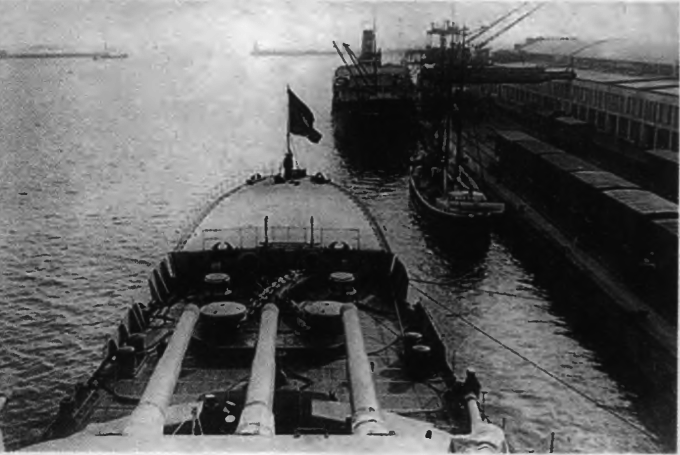
I do not dare to assert in any way that Sevastopoli were inborn peniters of the oceans, who would not care about the worst Pacific typhoon. But to what extent their unimportant seaworthiness prevented them from conducting artillery combat and whether they interfered at all, the question remains open. As far as I understand, the ships are fighting with the excitement of 3-4 points, well, the maximum 5 points, if that is the case and there are no other options (just as Togo did not have them, it will storm or not, and you can't let the Russians go to Vladivostok) . But under normal circumstances in 5, and even more so in 6 points, any admiral would prefer not to look for a fight, but to stand in the base and wait for good weather. Therefore, the question boils down to how stable the artillery platform was Sevastopol-type battleships with a wave of 4-5 points. Personally, I assume that with such excitement our battleships, if they went against the wave, they would probably have some problems with shooting directly in the nose, but I strongly doubt that the excitement could prevent them from fighting on parallel courses, i.e. the tower is deployed on board and is located sideways to the wave. It is highly doubtful that the German battleships on 5 points would stand up to the wave - such a roll would hardly have been able to demonstrate the wonders of accuracy. Therefore, I assume that our dreadnoughts' seaworthiness would be enough for a fight with the German dreadnoughts in the Baltic, but I can’t prove it strictly.
If we are talking about the driving characteristics of the ship, then it should be mentioned about its speed. Usually the speed in the 23 node is put to our ships in dignity, since the speed in the 21 node was standard for the battleships of those times. Our ships were in speed in the interval between the battleships and battlecruisers of other world powers.
Of course, it’s nice to have a speed advantage, but it should be understood that the difference in the 2 node did not allow the Russian dreadnoughts to play the role of a “high-speed avant-garde” and did not give them a particular advantage in battle. The British thought the difference in 10 speed was not significant, and I tend to agree with them. When the British decided to create a “fast wing” with their columns of 21-nodal battleships, they created powerful superdownnoughts like “Queen Elizabeth” designed for 25-nodal speed. The difference in the 4 of the node, perhaps, would allow these ships to cover the head of the enemy column, associated with the battle with the "twenty-one" battleships of the British line ... Anything can happen. Apart from the famous “Loop of Togo”, the Japanese in Tsushima constantly put Russian ships at a disadvantage, but the Japanese fleet had at least one and a half times the advantage in squadron speed. And then there is only 20%. In Russian ships and even less - 10%. For example, by engaging in combat at full speed and at a distance, say, 80 KB, while on the beam of the “König”, our battleship could go for half an hour to 10 KBT ahead. How much of this sense? In my opinion, in combat, the extra 2 of the speed node meant not too much for the Russian dreadnoughts and did not give them any decisive, or even any appreciable advantage. But it is in battle.
The fact is that even when designing battleships of the Sevastopol type, it was clear that the German fleet, if you wish it, will dominate the Baltic, and the construction of the first four Russian dreadnoughts cannot change anything - Hochzeeflot’s superiority in the number of ships lines. Therefore, the Russian battleships, with any access to the sea, would risk meeting with the forces of the enemy that were deliberately superior.
Perhaps, two knots of superiority in speed did not give the battleships of the “Sevastopol” type significant advantages in battle, but they allowed Russian ships to engage in battle at their own discretion. Our dreadnoughts were not suitable for the role of a “high-speed avant-garde”, but even if cruisers and destroyers miss the enemy, and suddenly, at the limit of visibility, signalmen will see the numerous silhouettes of German squadrons - the speed advantage will allow you to quickly break contact before the ships receive any significant damage. Taking into account the unimportant Baltic weather, finding an enemy, say, at 80 kbt, you can prevent it from breaking away, imposing a fight and breaking it, if it is weak, and if it is too strong, quickly go out of sight. Thus, in the specific situation of the Baltic Sea, an additional two speed knots for our battleships should be considered a very significant tactical advantage.
It is often written that “Sevastopoli” developed the 23 node with great difficulty, up to the modernization already in Soviet times (after which they went along the 24 node). This is a completely fair statement. But you need to understand that the battleships of other countries, having developed an 21 node on tests, usually gave a slightly lower speed in daily operation, which is a common practice for most ships. True, it happened and vice versa - German battleships sometimes developed on the acceptance tests much more than what they were supposed to. The same “Kaiser”, for example, instead of the node put to it by the 21 project, developed the 22,4, although I could not maintain such a speed in the future.
So the twenty-node speed for domestic dreadnoughts was not at all superfluous and can in no way be considered a project error. One can only regret that for the Black Sea dreadnoughts the speed was reduced from 23 to the 21 node. Taking into account the actual state of the boilers and “Gebena” machines, it is quite possible to assume that he would not leave the 23-node battleship.
Battleships of the "Sevastopol" type had an extremely short range.
But with this, alas, no arguing. No matter how sad, but it really is.
Russian dreadnoughts were not good in terms of seaworthiness and range. But if we ordered dreadnoughts in England ...
One of the main problems associated with seaworthiness was the overload of our ships, the main reason being that the chassis (turbines and boilers) turned out to be heavier than the project by 560 tons. Well, the problem with the stroke range arose because the boilers turned out to be much more voracious than expected. Who is to blame for it? Perhaps the English firm "John Brown", with which 14 January 1909, the joint board of the Baltic and Admiralty plants concluded an agreement on the technical management of the design, construction and testing of steam turbines and boilers for the first four Russian battleships in the sea?
Battleships like "Sevastopol" turned out to be extremely expensive and ravaged the country.
I must say that our battleships, of course, were a very expensive pleasure. And moreover, sadly aware of this, but the construction of warships in Russia very often turned out to be more expensive than the leading world powers, such as England and Germany. However, contrary to popular belief, the difference in the cost of ships was not at all times.
For example, the German battleship "König Albert" cost German taxpayers in 45.761 thousand gold marks (23.880.500 rubles in gold). Russian "Sevastopol" - in 29.400.000 rub.
The extreme high cost of domestic dreadnought, apparently, came from some confusion about how much the Russian battleship cost. The fact is that two costs of battleships of the Sevastopol type, 29,4 and 36,8 million rubles, appear in the press. But in this matter it should be borne in mind the particular pricing of the Russian fleet.
The fact is that 29 million is the price of the ship itself, and it is this that must be compared with the prices of foreign dreadnoughts. And 36,8 million is the cost of the battleship according to the construction program, which, in addition to the cost of the ship itself, includes the price of half the guns supplied additionally (a reserve in case the battle fails) and double ammunition, as well as, perhaps, something else something I don't know. Therefore, it is incorrect to compare the 23,8 million of the German Dreadnought and the 37 Russian.
However, the cost of the dreadnoughts is impressive. Maybe their construction really brought the country to the handle? It will be interesting to consider whether it would be possible to overwhelm our army with rifles / guns / shells, refusing to create armored leviathans?
The estimated cost of four battleships of the “Sevastopol” type was calculated in the total amount of 147 500 000,00 rubles. (together with the combat reserves, which I have indicated above). According to the GAU program (Chief Artillery Directorate), the expansion and modernization of the weapons factory in Tula and the construction of a new arms factory in Yekaterinoslav (production of rifles), followed by the transfer of the Sestroretsk rifle factory there, should have cost the 65 721 930,00 treasury in rubles . During World War I, 2 461 000 rifles were delivered to Russia, including 635 000 from Japan, 641 000 from France, 400 000 from Italy, England 128 000 from the USA, and 657 000 from the USA.
In 1915, the cost of the Mosin rifle was 35,00 rubles, which means that the total cost of rifles, if they were released in Russia and not bought abroad, would be 2 461 000 x 35,00 = 86 135 000,00 rubles.
Thus, 2 461 000 three-line rifles, along with factories for their production, would cost the treasury 151 856 930,00 rub. (65 721 930,00 rub. + 86 135 000,00 rub.), Which is already a little more than the Baltic dreadnought construction program.
Suppose we do not wish to build a mighty fleet capable of smashing the enemy into the sea. But we still need to defend our shores. Consequently, in the absence of battleships, we will have to build sea fortresses - but what will it cost us?
In the Baltic, the Russian fleet had Kronstadt as its base, but it was already too small for modern steel giants, and the famous Helsingfors was considered not very promising. The fleet was supposed to be based in Revel, and in order to adequately protect the future main base of the fleet and block the enemy’s entrance to the Gulf of Finland, they decided to build a powerful coastal defense - Peter the Great's fortress. The total value of the fortress was estimated at 92,4 million rubles. Moreover, this amount was not outstanding. For example, it was planned to allocate about 100 million rubles for the construction of a first-class fortress in Vladivostok. At that time, it was assumed that 16 356-mm guns, 8 305-mm 16 279-mm howitzers, 46 six-inch guns, 12 120-mm guns and 66-mm guns would be installed in the fortress.
If, say, to build the defense of the Gulf of Finland and Moonsund solely on the basis of coastal artillery, then at least 3 fortifications will be needed - Kronstadt, Revel-Porkalaud and, in fact, Moonsund. The cost of this solution will be 276 mln. Rub. (7 dreadnoughts commissioned by the Russian Empire cost 178 million rubles.) But you need to understand that such protection will not be able to block the enemy squadrons from entering Riga or the Gulf of Finland, and the Moonzund Islands themselves will remain very vulnerable - what is 164? guns on the whole archipelago?
The situation on the Black Sea is even more interesting. As is known, the Turks had Napoleonic plans to put into operation of their fleet three dreadnoughts.
If we tried to resist this not with the construction of the fleet, but with the construction of sea fortresses, only one attempt to cover the cities that suffered during the “Sevastopol wake” - Sevastopol, Odessa, Feodosia and Novorossiysk would cost much more than the construction of dreadnoughts. Even if we assume that to cover each of the cities, only a third of the cost of Peter the Great's fortress is needed (about 123 million rubles in total), then this is much more than the cost of the three Black Sea Russian Dreadnoughts (29,8 million rubles per piece or 89 million rub!) But, having built a fortress, we still could not feel safe: who would have prevented the same Turks from landing troops outside the zone of action of the fortress artillery and attacking the city from the land direction? In addition, one should never forget the excellent actions of the Russian Black Sea Fleet during the First World War. Our sailors stopped the sea communications of the Turks, forcing them to carry supplies to the troops by land, which was long and dreary, while they themselves helped the army by sea. The brilliant assistance to the troops of the seaside flank is very interesting and very detailed for the Patients in the book The Tragedy of Mistakes. It was the Black Sea Fleet, perhaps the only of all the fleets of the First World War, that landed successful landings, greatly helping the army to smash the enemy.
But all this would be decidedly impossible if the Turks had dreadnoughts, and we had fortresses. That the Turks would interrupt our communications, bombarded our coastal flanks, landed landings to the rear of our troops ... But we would pay for it much more expensive than for the Dreadnoughts!
Of course, no one cancels the need for coastal artillery - even with the most powerful fleet available, you still need to cover key points of the coast. But an attempt to ensure the security of a power from the sea, not with a sword (fleet), but with a shield (coastal defense) is obviously unprofitable financially and does not provide even a tenth of the opportunities that the presence of the fleet provides.
And, finally, the last myth - and, perhaps, the most unpleasant of all.
The project of the Baltic Plant (which later became a project of Sevastopol type battleships) was far from the best one presented for the competition, but was chosen because the commission chairman Academician Krylov was related to the author of the project Bubnov. That helped a relative, so that the plant received a chic order.
Even comment is disgusting. The point is not even that the Baltic plant was actually state-owned, i.e. He was in state ownership and therefore Bubnov personally did not expect any special gesheft from the “smart order”. The fact is that in the Baltic the Russian Empire had exactly four stocks, on which it was possible to build battleships, and two of them were located right at the Baltic Shipyard. At the same time building new battleships was originally intended in series of four ships. And therefore it doesn’t matter who developed the project and where. If the project were Russian, Italian, French, or even Eskimo, two battleships would be built at the Baltic Shipyard, simply because there was no place to build them anymore. So the plant received its order anyway.
This concludes the articles about our first dreadnoughts, but before putting an end, let me comment on two very common points of view on Sevastopol battleships with which I had the pleasure to read online.
Dreadnoughts - this, of course, not bad, but it would be better to build more cruisers and destroyers instead.
Theoretically, such an option is possible - in the end, a Svetlana type cruiser cost about 8,6 million rubles, and a Novik type destroyer - 1,9-2,1 million rubles. So, at the same cost, instead of one dreadnought one could build 3 light cruisers or pieces of 14 destroyers. True, the question arises about the stocks - how much money do not give, and one battleship in three cruising can not be redone. But these are, perhaps, details - in the end, the light cruisers could be ordered from the same England, there would be a desire. And, undoubtedly, their active use on the Baltic communications of the Kaiser added to the Germans a pretty headache.
But here the key words are “active use”. After all, for example, the Russian Baltic Fleet had many less cruisers and destroyers than it could have been, instead of the dreadnoughts of Svetlana and Noviki. But after all, even those light forces that were at our disposal, we used far from 100%! And what would have changed a few more cruisers? I'm afraid of nothing. If we had built a bunch of cruisers and destroyers and began to actively use them ... then yes. But then another question arises. And if we leave everything as it is, we will not build squadrons of cruisers and destroyers, but will we actively use the battleships? What would be then?
I urge dear readers to avoid one logical mistake, which no-no, yes, I notice on the Internet. It is impossible to compare the dreadnoughts standing in the harbor with the destroyers cruising on enemy communications and say that destroyers are more effective. It is necessary to compare the effect of the active actions of the battleships and the active actions of the destroyers, and then it was already to draw conclusions.
The question posed so smoothly flows into another plane: which is more effective - the active use of the multitude of light forces of the fleet, or the active use of smaller forces but supported by battleships? And what is the optimal ratio of battleships and light forces within the limits of the funds that were actually released for the construction of the Russian fleet?
These are very interesting, worthy of separate research questions, but examining them, we will give an excessive lurch to the field of alternative storiesWhat I would not like to do in this article. I will note one thing: with all the positive effect that several dozen light ships could have on enemy communications, cruisers and destroyers are unable to withstand the German Dreadnoughts. Neither destroyers nor cruisers are physically able to defend mine-artillery positions, the basis of our defense of the Gulf of Finland and Moonzund, with any degree of success. And to neutralize the old Russian battleships, the Germans needed to send a couple of their battleships of the first series, supporting them just in case with several Wittelsbachs. Therefore, it is absolutely impossible to completely abandon the dreadnoughts, but you can argue about the necessary number of them oh how long ...
Why build dreadnoughts if we still could not give the “last and decisive” battle to Hochzeeflotte? Wouldn’t it be better to limit the defense of the Gulf of Finland and Moonsund and build many coastal defense battleships?
My personal opinion is by no means better. Below I will try to give a detailed rationale for this thesis. In my opinion, the battleship of coastal defense was and remains a palliative, capable of solving only two tasks - the defense of the coast from the sea and the support of the coastal flank of the army. And he solves the first task out of his hands badly.
Talking about battleships of a very small displacement, like Russian “Ushakovs” or later Finnish “Ilmarinens”, probably is not worth it - such ships can fight with dreadnought only before the first hit of an enemy shell, while their own 254-mm guns are unlikely whether they can seriously scratch the battleship. The very successful activities of the Finnish armored personnel carriers during World War II are not related to the fact that coastal defense battleships can protect their own coast, but because no one attacked Finland from the sea in that war. The Finns did not defend their shores, they used the battleships as big gunboats, and as such, of course, their ships, armed with long-range guns, but capable of hiding in the skerries, showed themselves well. But this does not make the Finnish battleships ships capable of restraining enemy battleships in a mine-artillery position.
Similarly, it probably does not make sense to consider the huge battleships of predrednouath, the “last of the Mohicans” of the era of squadron battleships, which were built before the countries seized the predatory boom. Yes, these mastodons could easily “translate” with the dreadnoughts of the first series, while having even some chances of winning - but the price ... “Andrew the First-Called” and “The Emperor Paul I” cost the treasury more than 23 million rubles each! And if against the English "Dreadnought" the last Russian battleships still had some chances in a one-on-one battle, then there were no such opponents against a battleship like "Sevastopol". Given that the battleship Sevastopol is only 26% more expensive.
Of course, it can be argued that such a cost of the “Andrew the First-Called” is a consequence of its long construction and many alterations that the ship underwent on the slipway, and this will certainly be true to some extent. But if we look at the English ships, we will see about the same thing. Thus, to build large-tonnage coastal mastodons, which are similar in size and cost, but not similar in capabilities with the battleship, there is no meaning.
If we try to imagine a coastal defense battleship in the displacement of a classic squadron battleship of the beginning of the century, i.e. 12-15 thousand tons, then ... Anyway, but there is no way to make a small artillery ship stronger, or at least equal to a large one (except for tactical nuclear weapons, of course). Two battleships of the Borodino type cost approximately the dreadnought of the Sevastopol type (the cost of the battleship of the Borodino type ranged from 13,4 to 14,5 million rubles), but they cannot withstand it in battle. The protection of the battleships is weaker, the artillery power is obviously inferior to the dreadnought both in the number of guns of the main caliber and in the power of the guns, but, much worse, it loses many times in such important criteria as controllability. The organization of fire from one ship 10 times easier than with several. At the same time, the combat stability of a large ship is usually higher than that of two ships of a total equal displacement.
Therefore, building a fleet at the rate of two battleships on one enemy battleship (which most likely will not be enough), we will spend on the fleet about the same money as on the fleet of dreadnoughts, equal to the enemy fleet. But having created dreadnoughts, we will wield a sword capable of adequately representing our interests in the world's oceans, and by building battleships we will get just a shield, suitable only for the defense of the Gulf of Finland and Moonzund.
The battleship can participate in active marine operations, even if the enemy has superior strength. The battleship can support the raider actions of its own light forces, can strike at distant enemy shores, can try to lure part of the enemy fleet and try to smash it in battle (oh, if not for the cowardice of Ingenol, who turned back when the only squadron of Grand Fleet went straight to steel jaws of the High Sea Fleet!) The coastal defense battleship does not know how to do this. Accordingly, like any palliative, coastal defense battleships will cost as much, or even more, but will be less functional than dreadnoughts.
There is, however, one “but” in all these arguments. In one single place, in Moonsund, where our dreadnoughts did not have to go because of shallow depths, a strong, but small-sized battleship found a certain meaning. Such a ship could defend mine positions, like “Glory”, could operate in the Gulf of Riga, hit the enemy’s flank, if it gets to those shores ... It seems so, and not so much.
Firstly, it is worth bearing in mind that when the Germans seriously wanted to enter Riga, neither minefields, nor Glory could hold them, although they interfered fairly. So it was in 1915, when the Germans first retreated because of the fogs, but, waiting for good weather, they were able to drive off the Glory, rake our mine positions and enter the bay with light forces. So it was in 1917, when “Glory” died. And, sadly enough, we lost a large warship, but could not inflict equivalent damage to the enemy. No one detracts from the courage of the officers of “Glory” who led the “ship committees” under the fire of the many-times superior enemy and those sailors who honestly fulfilled their duty — our eternal gratitude and kind memory to the soldiers of Russia! But with the existing material part, our sailors "could only show that they know how to die with dignity."
And secondly, when the base was chosen for the Baltic Fleet, the Moonsund Archipelago was considered as one of the main contenders. For this, it was necessary not so much - to carry out dredging so that the newest dreadnoughts could go in, nothing was impossible in it. And although in the end they stopped at Revel, they nevertheless assumed, in the future, to carry out these dredging works, ensuring the entrance of the Dreadnoughts to Moonsund. One can only regret that this was not done before the First World War.
Well, it's time to take stock. In my opinion, “Sevastopol” type battleships can rightly be considered a success of domestic industry and design ideas. They did not become ideal ships, but took a worthy place in the ranks of foreign peers. In some ways, our ships were worse, but in some ways they were better than their foreign counterparts, but in general they were least "Equal among equals". Despite a number of shortcomings, the battleships of the “Sevastopol” type could very well with their steel chest protect the sea borders of the Fatherland.
And as far as I could substantiate this my opinion, judge you, dear readers.
Thank you for attention!
The list of used literature:
I.F. Tsvetkov, "Sevastopol type battleships".
A.V. Skvortsov, "Sevastopol type battleships".
A. Vasiliev, "The first battleships of the red fleet".
V.Yu. Gribovsky, "squadron battleships of the" Tsarevich "and" Borodino "types.
V.B. Mujenikov, "German battle cruisers".
VB Men, "The battlecruisers of England".
V.B. The men, the "Kaiser" and "Konig" battleships.
L.G. Goncharov, "Course naval tactics. Artillery and armor."
S.E. Vinogradov, "The Last Giants of the Russian Imperial Navy".
L.A. Kuznetsov, "Nasal affair battleship" Paris Commune ".
L.I. Amirkhanov, "Sea Fortress of Emperor Peter the Great".
V.P. Rimsky-Korsakov, "Managing Artillery Fire".
"Description of the instrumentation management artil. Fire sample 1910 of the year."
B.V. Kozlov, "Linear ships like" Orion ".
S.I. Titushkin, "Bayern" battleships.
A.V. Mandel, V.V. Skoptsov, "Battleships of the United States of America".
A.A. Belov, "Armadillos of Japan".
V. Kofman, "King George V type liners"
K.P. Puzyrevsky, "Combat damage and death of ships in the battle of Jutland".
Taking this opportunity, I express my deep gratitude to my colleague "countryman" from the alternative history website for the brilliant research on the effectiveness of the Russian and Japanese artillerymen firing in the Russian-Japanese war (series of articles "On the Accuracy of Shooting the Russian-Japanese War" and "On the Budget Ratio" of the naval department and the Ministry of War of the Russian Empire at the beginning of the twentieth century ", which I copied without a twinge of conscience. The articles of this outstanding author can be found in his blog: http://alternathistory.org.ua/user/zemlyak.
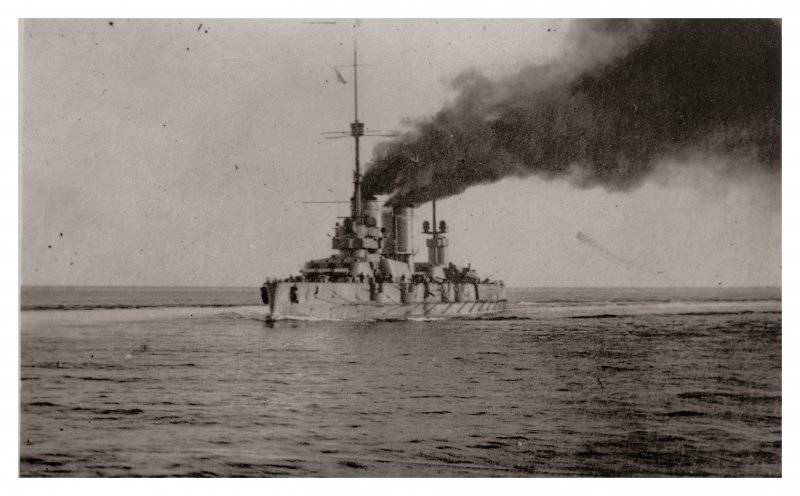
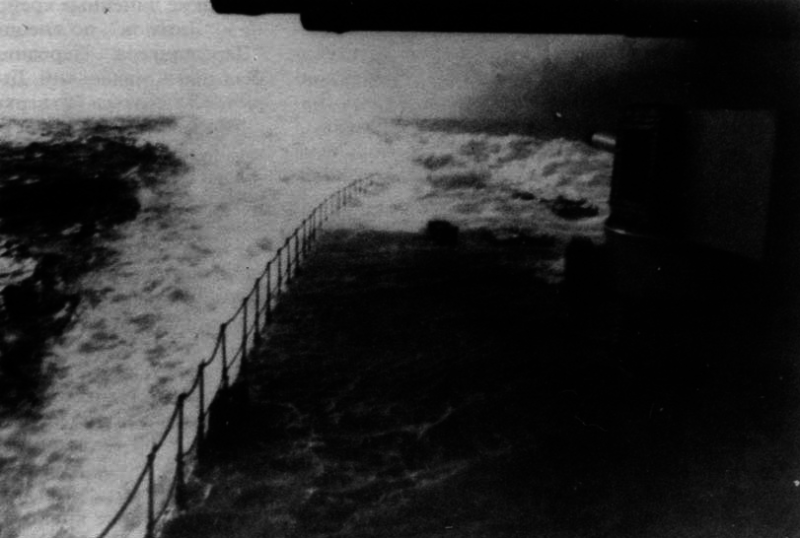
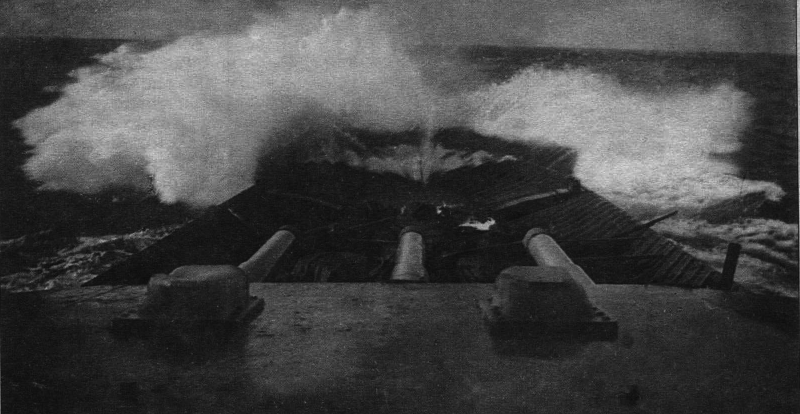
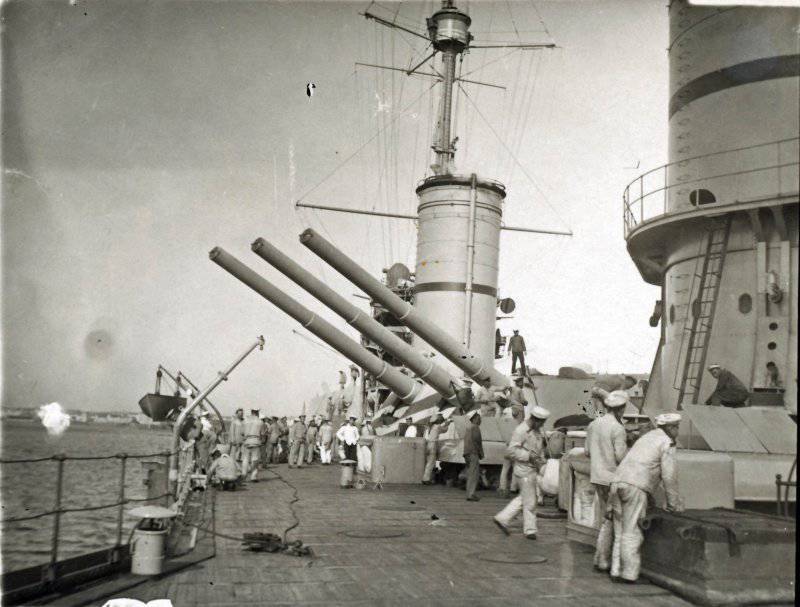
Information